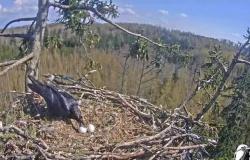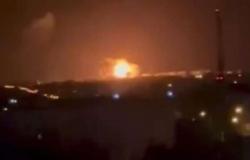This morning it rained in a large part of Latvia, but during the previous, spring-like sunny days and Easter weekend, which is expected to be record warm, there is an intense spring migration of birds, which will be seen by many who will go out into nature on holidays.
Ornithologist Elīna Gulbe says that grebes – plump, black waterfowl with a white forehead and a nasty voice – have already arrived at the nesting places. At the moment, the spring fights are going on for the male lions, but the female could start laying eggs around April 10. In recent years, there is a tendency to winter in Latvia in small numbers, but mostly when returning from Europe. These birds have appeared here more than a week ago.
Field
Photo: Elina Gulbe
On sunny days at the weekend, when we go out in nature, we will also hear a mighty symphony of other birds’ voices.
“The finches could sing more, there is news of the first terns wintering in northern Africa. Yes, the starlings will sing really well – that’s for sure!” says the ornithologist.
Reports have already been received from all regions of Latvia about the return of the white storks, which we await as heralds of spring. There were 53 messages on the dabasdati.lv website this morning. The first to look for the nests are the males, and this year the earliest one was very quick – it was observed already at the end of February, and the black stork – in the middle of March.
In general, the arrival of terns from southern Africa is about the same as every year, and they too will begin to lay eggs en masse around April 10. There are around 14,000 pairs of white storks nesting in Latvia, the number will be specified by the large stork census planned for this year, which takes place every ten years.
“The data show that nesting results are decreasing very steadily. When there were fewer storks, they raised more babies,” says Gulbe.
Anyone interested has been able to watch the events of birds, including storks’ nests, since 2012 on the live cameras of the Latvian Nature Foundation. At the moment, eight are connected, and four or five more are planned to be installed, explained ornithologist Jānis Ķuze, who had gone to install a new camera.
“There are already three nests in which birds are already hatching eggs. The two sea eagle nests – the already well-known nest in Durbe, where two eggs are hatching this year, and the nest in Ķemeri National Park is hatching one – they had an accident, the first egg was passed by the nest hole, so there also stayed. Eggs are already hatching in a raven’s nest in Riga next to the children’s hospital,” said Ķuze.
Currently, one bird has returned to the black stork’s nest monitored by the Latvian Nature Foundation, and both to the white stork’s nest. However, the most active is the migration of passers-by, mainly various geese, which in turn go further north through Latvia. Bird watching excursions led by ornithologists are scheduled in many places in Latvia during the Bird Days next weekend.
Tags: Storks returned regions Latvia year nests counted Article
-





